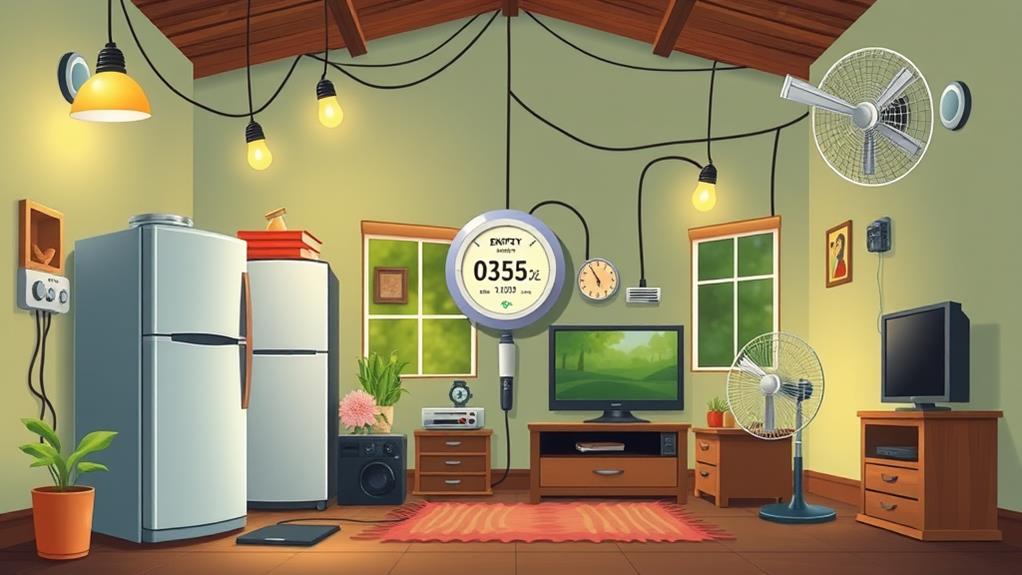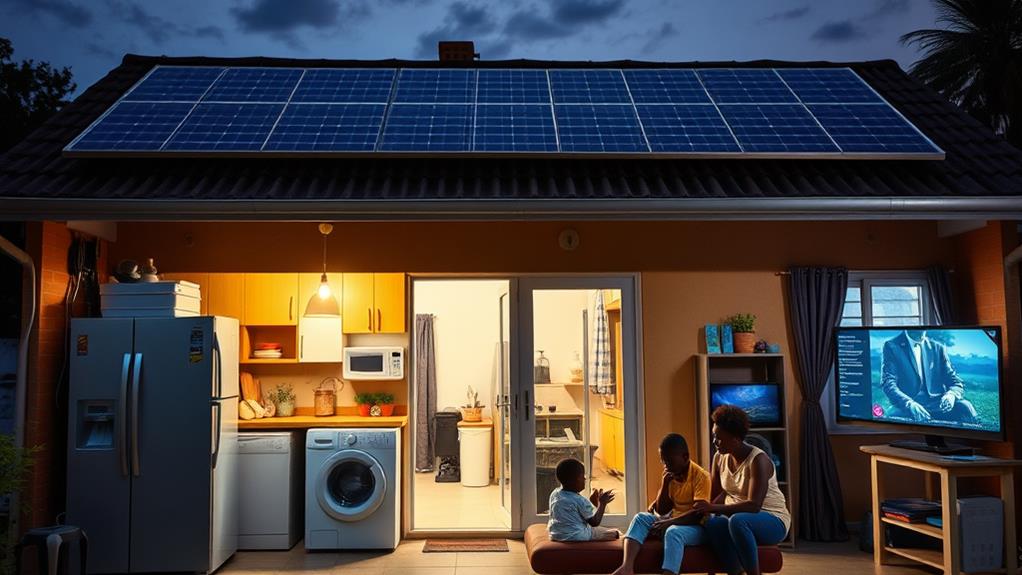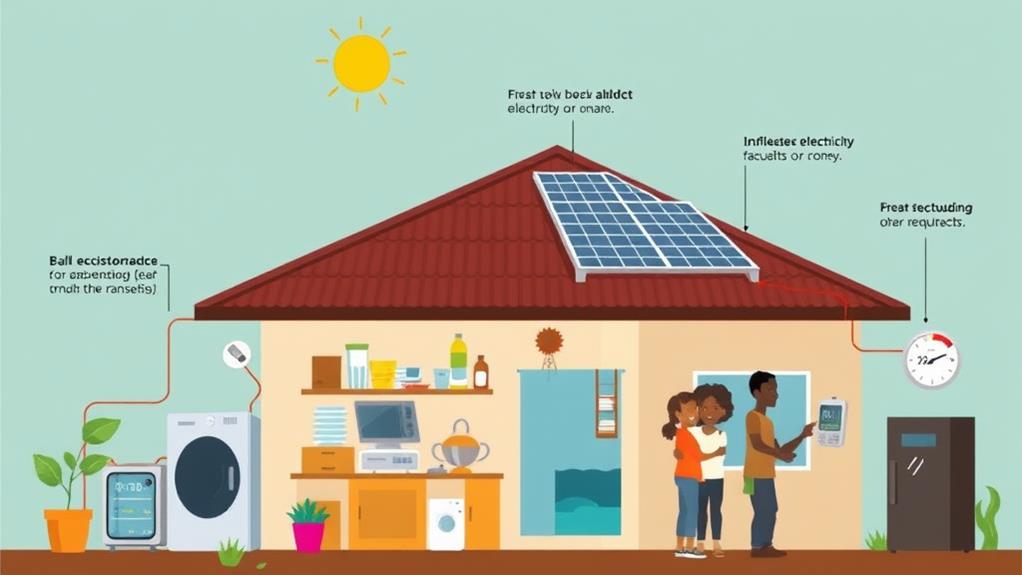Imagine a bustling marketplace where every stall represents a different household's energy use. In Kenya, the contrast between urban and rural areas is just as striking as the variety of goods in that market. Urban households typically consume between 150 to 300 kWh per month, thanks to better access to electricity and a higher number of appliances. Meanwhile, rural homes often rely on off-grid solutions, leading to much lower consumption. But what happens when electrification initiatives bring modern energy sources to these rural areas? Let's explore the impact of this shift and how it might reshape energy consumption patterns across the country.
Average Household Energy Consumption

Analyzing the average household energy consumption in Kenya reveals intriguing patterns influenced by various factors such as urbanization, income levels, and access to electricity.
You'll find that energy sources vary greatly, with a mix of grid electricity, renewable energy like solar, and traditional fuels. The choice of household appliances and their efficiency also plays a vital role. More efficient appliances can drastically reduce consumption, but they're often less accessible to lower-income households.
Leveraging residential solar panels can greatly reduce electricity bills by up to 50%, making them a viable option for many households.
Seasonal variations impact energy use, especially in regions with distinct wet and dry seasons. During colder months, there's a spike in energy consumption for heating.
Energy policies in Kenya, aimed at promoting energy conservation and renewable energy, have started to make a difference, yet there's still room for broader implementation.
Cultural practices also shape energy usage. In many households, cooking methods remain traditional, relying on firewood or charcoal, which impacts overall energy consumption patterns.
Electricity access is steadily improving, but disparities remain. Embracing renewable energy sources and enhancing appliance efficiency can drive down consumption.
Ultimately, your lifestyle habits, including energy conservation practices, greatly influence how much energy your household consumes.
Urban Vs. Rural Energy Usage
When comparing energy usage, you'll find urban households in Kenya consume considerably more kWh due to higher appliance density and greater access to the grid.
In contrast, rural areas face energy challenges, including limited grid connectivity and reliance on alternative sources like solar.
This stark contrast highlights the disparities in energy consumption and access between urban and rural regions.
Urban Consumption Patterns
Understanding the discrepancies in energy consumption between urban and rural areas in Kenya is crucial for grasping the nation's overall electricity usage.
In urban areas, energy consumption behavior is distinct due to higher electrification rates and diverse energy needs. Urban energy trends show that households in cities like Nairobi and Mombasa consume more electricity, averaging around 150-300 kWh per month. This is primarily driven by the usage of multiple electrical appliances, lighting, and entertainment systems.
You'll notice that urban dwellers have better access to a stable electricity supply, which allows for increased consumption. For instance, refrigerators, air conditioning units, and other high-consumption devices are more common in urban settings.
Urban energy trends also highlight a growing shift toward renewable energy sources, such as solar power, driven by both environmental consciousness and the quest for energy independence.
Rural Energy Challenges
In stark contrast to urban areas, rural regions in Kenya face considerable energy challenges that contribute to lower electricity consumption. Rural electrification rates remain low, with many households relying on biomass usage for cooking and heating, leading to severe energy poverty.
You'll find that limited access to the national grid often forces communities to seek off-grid solutions, such as solar energy. However, these solutions, while sustainable, aren't yet widespread enough to meet all energy needs.
Community initiatives play an essential role in bridging this gap. Local resources, including micro-hydro projects and biogas, are increasingly utilized, but scalability remains an issue.
Energy poverty persists, limiting economic development and quality of life. Analyzing data from the Kenya National Bureau of Statistics, rural households consume notably fewer kilowatt-hours compared to urban counterparts, primarily due to insufficient infrastructure and lower income levels.
For rural Kenya to achieve energy independence and sustainability, more investment in off-grid solutions and harnessing local resources is essential.
Impact of Modern Appliances

When you introduce modern appliances into your home, you'll notice a significant increase in energy consumption.
However, newer models often come with energy-efficient features that can lead to substantial savings.
By utilizing solar panels and other renewable energy sources, you can further offset this consumption and reduce your dependency on the traditional power grid.
Increased Energy Consumption
Modern appliances have greatly increased household energy consumption in Kenya. As more households adopt devices like refrigerators, washing machines, and air conditioners, the demand for electricity surges. This spike in energy use challenges the push for sustainable energy and emphasizes the need for energy conservation.
To mitigate this, you can focus on:
- Energy awareness: Educate yourself and your community about efficient energy use.
- Smart technologies: Invest in energy-efficient appliances that automatically adjust to reduce consumption.
- Government policies: Advocate for policies promoting renewable sources and energy-saving measures.
- Energy audits: Conduct regular energy audits to identify and rectify inefficient energy use.
Data shows that household energy consumption has risen by approximately 15% annually due to modern appliances. While these devices offer convenience, they also strain the grid, which relies heavily on non-renewable sources.
By engaging in community initiatives and supporting government policies, you can contribute to a balanced approach that champions both modern comforts and sustainable energy practices.
Analyzing current trends and employing smart technologies will help achieve a sustainable energy future in Kenya. Empower yourself with knowledge and tools to make informed energy choices, ensuring freedom from excessive energy costs and environmental impacts.
Efficiency and Savings
Households embracing modern appliances can see remarkable efficiency and savings when these devices are used wisely. Smart meters, for instance, allow you to monitor your energy consumption habits in real-time, enabling more informed decisions.
An energy audit can identify areas where energy efficiency can be improved, often leading to considerable reductions in your monthly electricity bills.
Switching to appliances that harness renewable sources like solar energy greatly boosts energy conservation. Solar panels can power a variety of modern devices, reducing your dependence on the grid. This shift not only mitigates energy costs but also promotes sustainable practices.
Energy-efficient appliances, such as LED lighting and inverter air conditioners, consume less power while delivering superior performance. By upgrading to such devices, you can lower your kWh usage without sacrificing comfort or convenience.
Adopting sustainable practices, like using smart thermostats to regulate home temperatures, further enhances savings. These devices automatically adjust settings based on your daily routines, ensuring peak energy use.
Energy Infrastructure in Kenya
Kenya's energy infrastructure is a dynamic and rapidly evolving sector, driven by both governmental and private investments. You'll find that the country is making significant strides towards improving energy access through a mix of renewable sources and innovative energy solutions.
The focus on grid expansion and electrification initiatives is essential to Kenya's energy policy, ensuring power reliability and sustainable solutions for all. Additionally, solar energy plays an important role in this transformation, leveraging advanced technologies to harness sunlight efficiently.
Key aspects of Kenya's energy infrastructure include:
- Solar energy: With abundant sunshine, solar energy projects are expanding, providing off-grid solutions to remote areas.
- Renewable sources: Investments in geothermal, wind, and hydroelectric power are diversifying the energy mix.
- Grid expansion: Ongoing projects aim to extend the national grid, reaching underserved communities.
- Electrification initiatives: Governmental programs are accelerating the pace of rural electrification, boosting overall energy access.
Kenya's infrastructure investment is substantial, supported by both local and international stakeholders.
This focus on energy innovation is vital to meeting the growing demand for electricity while maintaining a commitment to sustainable practices. As you explore how many kWh a house uses in Kenya, consider how these infrastructure developments impact energy consumption patterns and overall access to reliable power.
Factors Affecting Electricity Bills

When analyzing electricity bills in Kenya, several key factors come into play, greatly influencing the total cost. Energy pricing is a primary element, often fluctuating due to economic factors and government policies.
Seasonal variations also affect your bills; higher consumption usually occurs during colder months when heating appliances are in use.
Household size profoundly impacts electricity usage. Larger families typically consume more energy due to increased appliance usage and diverse lifestyle choices. For instance, homes with multiple entertainment devices or extensive lighting systems will naturally see higher bills.
Utilizing renewable power systems can markedly lower costs compared to traditional methods, making them a viable long-term option.
The type of energy sources you use can affect costs. Opting for renewable options like solar panels may reduce long-term expenses, despite initial setup costs. Government policies promoting renewable energy could also offer financial incentives, easing your monthly financial burden.
Demographic influences such as urban versus rural living conditions play a role in electricity consumption. Urban households often have higher energy demands due to modern amenities and increased appliance usage.
Lastly, economic factors like income levels and overall economic stability can dictate energy affordability, making it essential to take into account how these variables interact to influence your monthly electricity bills.
Understanding these factors can help you manage your energy expenses effectively.
Tips for Reducing Energy Usage
Smart meters can be a game-changer when it comes to reducing your energy usage. They provide real-time data, allowing you to make informed decisions about energy conservation. For instance, integrating smart meters with monitoring systems can enhance your ability to track and optimize energy consumption.
To further optimize your usage, consider the following tips:
- Conduct energy audits: Identify inefficiencies and prioritize insulation improvements. Proper insulation can reduce energy consumption by up to 30%.
- Adopt solar energy: Utilize renewable resources to lower reliance on the grid, especially during peak usage times.
- Install energy-efficient lighting: LED bulbs use up to 75% less energy compared to traditional incandescent bulbs.
- Implement smart home technologies: Automate load management to guarantee devices are off when not needed.
Behavioral changes are also vital. Simple actions like turning off lights when leaving a room or unplugging devices when not in use can lead to significant reductions.
Emphasize energy conservation by setting goals and tracking progress through smart meters. The data-driven insights will empower you to make more sustainable choices, giving you the freedom to control your energy footprint effectively.
Conclusion
You'd be shocked at how diverse household energy usage in Kenya can be! Urban dwellers guzzle between 150 to 300 kWh monthly, thanks to their plethora of modern appliances. Conversely, rural households sip far less, relying on off-grid solutions. As electrification sweeps the nation, expect a surge in energy consumption. To avoid skyrocketing bills, embrace energy-saving tips. Understanding these dynamics is essential for managing your electricity use efficiently in this rapidly evolving landscape.
